Violation of the natural physiology of the respiratory system affects the activity of the whole organism. Septoplasty is performed to correct the existing curvature of the nasal septum. The operation belongs to the field of ENT therapy. The cost of the operation is set taking into account the duration and complexity of the process.
What it is
Septoplasty is the correction of nasal septum problems. The otolaryngologist corrects the bone and cartilage tissues inside the cavity. Surgical intervention is performed strictly according to indications. When a patient is guided by aesthetic considerations, a plastic surgeon should be consulted.
Septoplasty of the nasal cavity is needed to correct the deformation of the septum.
The curvature disturbs the distribution of air masses. Pressure builds up inside the nose during inhalation. Also, curvature can provoke the occurrence of other diseases.
The reasons for the appearance of curvatures:
- trauma;
- transferred rickets;
- heredity;
- features of the structure of the bones of the skull.
Septoplasty will help correct these defects. This is a method of surgical intervention. If necessary, it can be combined with other types of rhinoplasty.
Operation types
The doctor chooses a recovery method depending on the complexity of the problem. The type of deformation has an important influence on the choice.
Kinds:
- laser;
- endoscopic;
- open;
- radio wave;
- ultrasonic.
Laser is used for small changes. It is carried out bloodlessly, due to the minimal effect on the tissue by the laser. The beam seals the cut vessels. As a result, bleeding is not observed.
The operation is performed under local anesthesia.
The video endoscope helps the otolaryngologist to monitor the work. The recovery period lasts 1-2 days. Endoscopic is considered a minimally invasive correction method. The surgeon inserts a special illuminated probe into the nasal cavity. The instrument is equipped with a camera that displays an image on a monitor.
The surgeon, approaching the septum, makes incisions, then removes the deformed areas. The surgical intervention takes place under local freezing, general anesthesia. Fast recovery is considered an advantage of the method. An open one is used to eliminate pronounced defects, such as a crooked nose, large neoplasms, a bone thorn.
This type is often combined with rhinoplasty for the desired aesthetic result. During radio wave septoplasty, the surgeon makes small incisions on the surface of the mucous membrane, then the deformed septum is removed, the correction is made, and the cartilage returns. The otolaryngologist uses a video endoscope and a radio knife in his work. This type of operation does not provoke blood flow.
Unlike laser septoplasty, bone structure is corrected. Ultrasound helps to eliminate severe curvature. Ultrasound quickly cuts the mucous membrane, seals blood vessels, destroys growths. The operation takes place without blood loss.

 Don't miss the most popular column article: Cannula - what is it, how is it used in cosmetology and medicine.
Don't miss the most popular column article: Cannula - what is it, how is it used in cosmetology and medicine.Difficulty
There are 3 categories:
- 1 degree - a slight curvature of the septum;
- Grade 2 is established when the cartilage is significantly deformed, there are thorns, protrusions;
- Grade 3 is marked by severe deformation of the cartilaginous plate, when there is fragmentation, perforation.
In medical practice, there are 4 types of deformities:
- C-shaped - a nose with a hump, which is believed to be caused by transmission at the gene level.
- S-shaped - appears as a result of injury, in rare cases it is transmitted by heredity.
- Posterior-anterior S-shaped - refers to congenital malformations and is more difficult to correct than others. Correction takes place in several steps: first, breathing is adjusted, then smell, then speech.
- Curvature directed to the lower, upper jaw - straightens with a combination of activities. Sometimes the bite is additionally corrected.
Correction is carried out only by surgery, regardless of the degree and type of deformity.
Indications
Septoplasty of the nasal septum eliminates organ problems. Slight deformation is invisible from the side. If nothing bothers you, you don't have to go to the clinic.
The reason for the appeal is:
- Deformation of the nasal septum.
- Difficulty breathing.
- Snore.
- Frequent diseases of the ENT organs.
- Dry mucous membranes.
- Frequent bleeding.
When the structure of the septum is disturbed, difficulties arise associated with the respiratory process: a person snores in a dream, feels dry. At the same time, the paranasal sinuses are subject to frequent diseases - they are constantly disturbed by sinusitis, allergic rhinitis. The latter appears as a result of compensatory curvature. Subsequently, hypertrophy of the nasal concha develops.
The listed symptoms indicate not only the curvature of the nasal septum. To clarify the diagnosis, you need to sign up for a consultation with an otolaryngologist and get tested. If the diagnosis is confirmed, surgery will be needed to relieve the problem.
Contraindications
The curvature of the nasal septum can lead to a deterioration in the quality of life, since the respiratory process is confused, because of this, heart failure can subsequently develop, the brain and metabolic processes are disrupted. Small surgical intervention can get rid of these problems, however, it is not always possible to carry it out.
Contraindications:
- acute infectious diseases;
- diseases of internal organs of a chronic nature;
- pregnancy, lactation;
- oncology, diabetes;
- mental disorder;
- poor blood clotting;
- age less than 18 years.
Age is a relative prohibition on surgery. The cause is the growth and development of bone and cartilage tissue. The operation can provoke a violation of the symmetry of the face. The process is completed by the age of 16.
A young man under 18 is not operated on, but in special cases, the operation is performed from the age of seven. Septoplasty is not recommended after 60 years, but the doctor agrees to take the risk if there are serious indications.

 Don't miss the most popular column article: Alentova Vera after plastics - the last photos, what operations were carried out, how the star changed.
Don't miss the most popular column article: Alentova Vera after plastics - the last photos, what operations were carried out, how the star changed.Pros and cons
The advantages of laser surgery:
- low injury risk;
- minimal risk of complications, blood poisoning;
- duration;
- lack of edema;
- passes without blood loss;
- no suturing required;
- fast rehabilitation period;
- breathing is restored after 2-3 days.
Disadvantages:
- the laser is not used for S-shaped deformation;
- high price value;
- correction is carried out only to correct the cartilage tissue;
- many contraindications.
Advantages of endoscopic septoplasty:
- minor damage to cartilage tissue;
- control over the operation with an endoscope;
- great success with C and S-shaped deformities;
- sutures are applied in the lower zone of the passages.
Minuses:
- the procedure takes longer than the laser;
- great blood loss;
- there is a possibility of infection;
- there is a risk of injury;
- there is a possibility of postoperative complications;
- breathing is restored for 5–7 days.
Potential risks:
- restoration of nasal obstruction;
- discoloration of the skin;
- scar formation;
- change in sensitivity;
- accumulation of fluid;
- asymmetry.
What is included in the procedure
Septoplasty includes excision, restructuring of the nasal septum, cartilage, and bone structure. The surgical intervention takes place under local, general anesthesia. The surgeon's work is done through the nostrils. No external incisions are made. Only the curvatures are removed, the main part of the nose is not affected.
The cost
If the patient has indications, the operation is done free of charge in state institutions. When performing an operation in private clinics, the price depends on the qualifications of the medical staff, the level, category of the institution, and the length of stay in the hospital.
Factors affecting the price:
- diagnosis;
- stage of the disease;
- method of performing the operation.
If the surgical intervention was unsuccessful, additional manipulation will be required. Its cost is determined privately. On average, it will be 50% more expensive than the first. This is explained by a complex technique. If the operation is required through the fault of the surgeon, the elimination of the consequences will be free of charge: all costs will be borne by the clinic.
Preparing for surgery
The decision to carry out surgical actions is taken by the otolaryngologist. He examines the nasal cavity, examines the data of computed tomography. The patient comes for a consultation with X-rays of the paranasal sinuses. If the doctor gives a conclusion about the surgical intervention, a full examination is carried out at the clinic the day before.
Standard preparation for surgery includes:
- examination by a therapist;
- consultation with an anesthesiologist;
- laboratory tests (total blood, urine, antibodies to hepatitis viruses, HIV, RW);
- ECG;
- chest x-ray.
By giving consent to surgery, you need to follow the regime:
- quit smoking in 3 weeks;
- stop drinking alcohol in 2 weeks;
- Do not take medications for 14 days before the operation;
- 7-10 days the day before, do not be under ultraviolet rays.
The examination performed gives a complete assessment of the patient's health. The doctor, based on the data obtained, selects anesthesia, identifies the presence of contraindications. Compliance with the regimen will facilitate the postoperative period. The risk of complications will decrease.
Anesthesia
The surgical intervention is performed under local freezing, general anesthesia. The first option is chosen if the curvature of the septal cartilage is corrected. Stop at it for laser correction. Sometimes local anesthesia is supplemented with sedatives.
The second variant of anesthesia is administered intravenously. It is used if the nasal septum is being corrected. General anesthesia is used when septoplasty is combined with rhinoplasty.
The choice of anesthesia depends on:
- type of operational actions;
- the degree of deformation;
- individual characteristics of the patient.
These questions are clarified at the preparatory stage.
What is required in the hospital
Septoplasty of the nasal septum is planned in advance.Therefore, there is time to prepare for the visit to the clinic.
You need to take with you:
- the passport;
- personal hygiene items;
- replaceable shoes;
- clothes.
In most cases, this is sufficient. The medical institution provides patients with everything they need.
Septoplasty and vasotomy
Septoplasty of the nasal septum with vasotomy of the lower cavities is performed according to the individual indications of patients. A complex measure is often carried out for vasomotor rhinitis, when the mucous membrane looks swollen, thickened, the slightest touch causes irritation. The surgical intervention is performed on the lower shells.
The use of two techniques simultaneously facilitates nasal breathing. Rehabilitation after combined surgery takes longer. Vasotomy plus septoplasty is rather difficult. The operation is performed under general anesthesia. The patient remains in the clinic for rehabilitation for 3 days.
If complications do not appear, further recovery continues at home. The combined intervention reduces the risk of injury inside the aisles. Also, you do not have to go through the recovery period twice.
Operation progress - step by step
Surgical intervention is performed under general, local, combined anesthesia, depending on the type of change in the nasal septum.
Algorithm of actions:
- A small incision is made.
- The soft tissue is separated from the bone-cartilaginous framework.
- The partition is straightened.
- Excess tissue is removed.
- Bone fragments are displaced.
- The new position of the tissues is fixed.
- Seams are applied.
Gauze tampons are inserted into the nostrils. They fix the position and stop bleeding.
Where and how the incisions are made
The incisions are made only inside, near the septum between the nostrils. The type of offset determines the choice of tool.
The incision is made:
- scalpel;
- a radio knife;
- a laser beam;
- ultrasound.
The last two immediately seal the vessels. No blood flow appears.

 Don't miss the most popular column article: How and why ribs are removed - efficiency, photos before and after surgery.
Don't miss the most popular column article: How and why ribs are removed - efficiency, photos before and after surgery.How long does the operation take
The duration of the intervention depends on the nature of the difficulty. Normally, the operating process takes from 30 minutes to 3-4 hours.
How long does the hospital stay
If the operation has gone without complications, 2-3 days are enough to stay in the clinic. Physical activity is limited as much as possible; bed rest must be observed. Then the patient is discharged and visits a medical institution to monitor the condition during the rehabilitation period.
Rehabilitation period
The recovery period takes place individually. The patient must follow the doctor's recommendations, monitor changes in health. In the first days, painful sensations may bother, swelling, hematomas often appear.
Temperature rise possible. It is better to spend 2-3 days after the operation in a hospital, where anti-inflammatory, analgesic drugs, antibiotics will be administered in a timely manner.
To relieve puffiness, the doctor prescribes Oxymetazoline.
Features of the mode:
- Tampons remain in the sinuses for 2–3 days. You cannot touch them. You can only breathe through your mouth.
- Nasal breathing is restored after 5-7 days. It is necessary to refrain from sneezing, intensive nasal hygiene.
- The sinuses should be flushed daily with saline.
- For 2-3 weeks, you need to stop wearing glasses, any stress, spicy food, hardware cosmetology, thermal procedures.
Final tissue healing occurs after a month. The patient does not need bed rest. The food you eat remains the same, but the food should not be very hot.
Possible complications
Septoplasty of the nasal septum rarely leads to complications. Painful sensations, swelling disappear in 2 weeks.The discomfort disappears by the end of the recovery period.
Possible complications:
- bleeding;
- perforation of the septum;
- the occurrence of adhesions;
- mechanical damage;
- loss of sensitivity;
- inflammation, hematoma.
Bleeding occurs through the patient's fault. If, for example, he drank an alcoholic drink, he often bent over, slept on his stomach. Blood flow most often appears at the beginning of the recovery period.
The main complication is perforation of the septum, when a hole forms in the cartilage. To eliminate it, a reconstructive septoplasty is required. Adhesions appear at the incision sites. If the patient does not experience discomfort, there is no need to worry about their existence. Otherwise, excision should be performed.
Mechanical damage occurs due to the fault of the doctor. Inaccurate actions during the operation lead to damage to adjacent tissues. You should be careful when choosing a clinic to avoid this.
If nerve endings are damaged, tissue sensitivity is lost. It recovers on its own, but this period can drag on for years.
Hematomas disappear after 2–3 weeks. If the infection managed to get inside, antibiotic therapy is performed.
Because of what the risk of complications increases
The consequences are practically excluded with high qualifications of specialists, proper training. Breathing difficulties are observed after the operation for several days. This phenomenon is considered temporary and does not apply to complications. Breathing difficulties gradually disappear.
The increased risk of consequences is associated with:
- tissue injury after surgery;
- getting an infection into an unhealed wound;
- technically incorrectly performed surgical intervention;
- non-compliance with aseptic conditions in the operating room;
- improper dressing early after surgery;
- non-compliance by the patient with the prescribed regimen;
- the presence of chronic diseases that affect the immune system, the general condition of the skin;
- inflammatory process of the mucous membrane, which is in the stage of exacerbation or remission.
Measures to prevent the development of complications:
- strict adherence to the food diet;
- rejection of bad habits;
- conducting examinations to identify contraindications to surgical intervention;
- the use of sterile material for dressings;
- the use of wound healing ointments;
- antibiotic therapy when symptoms of infection are detected;
- the use of drugs that increase the clotting of blood cells.
On the first day after the operation, tampons are inserted into the nasal passages. They absorb protruding blood, if any, and restrain the flow of air masses from penetrating inside. In order to prevent the formation of adhesions, it is recommended to perform breathing exercises.
What to do if the operation fails
A small number of surgical interventions can be considered unsuccessful. The quality of the actions performed is influenced by the patient's behavior, his compliance with the doctor's prescriptions, the qualifications of the doctor himself. The anatomical features of the patient play an important role. If after surgery the shape of the nose is deformed, a second correction is needed.
It is also necessary when the partition remains curved. This happens when there is insufficient fixation of the cartilage tissue. When planning a surgical intervention, the patient must represent the expected result. The operation eliminates breathing problems if they interfere with a full life. When a patient wants to change the shape of the nose, he must know what specific shape he needs.
In order for the surgical intervention to be successful, it is necessary to take a responsible approach to the choice of a clinic, a doctor, and read reviews.
Don't go for a low price.It is necessary to pay attention to the equipment.
The consequences of an unsuccessful surgical intervention are corrected in 3 ways:
- repeated operation;
- simple correction;
- contour plastics.
Contour correction will help correct the unsuccessful result from nasal septum septoplasty.
The first option is carried out with serious complications. It is performed under general anesthesia and is a complete open / close operation. Reoperation is more difficult to carry out. Large tissue excision makes it difficult to achieve the desired result.
The consequences of corrective rhinoplasty are often eliminated. Unforeseen complications appear during rehabilitation. They are related to the anatomy of the nose, therefore corrective manipulations are included in the list of mandatory. Thanks to the correction, breathing is stabilized, minor errors are eliminated, and scars are removed.
Contouring has a temporary effect. Six months or a year later, you will have to repeat the procedure, but the method is painless. With it, you can smooth the tip of the nose, create symmetry, and eliminate minor bumps.
What to do in case of a cold after surgery
Infection with colds after surgery has unpleasant consequences. The recovery period lasts longer than usual, and self-medication is strictly prohibited. When the first symptoms of ARVI appear, you need to contact the clinic where the operation took place. Cold treatment should be supervised by the correcting physician.
Repeated surgery is often performed. The doctor will place another plate. Cartilage is taken from the ear. If the cold is "mild", it is enough to raise the immune system. You can not carry the disease on your feet, you need to take a sick leave and lie down. You should warm up, sweat. When the temperature is below 38 degrees, it is not knocked down. You need to drink liquid with lemon, eat chocolate, grapes.
Septoplasty is performed to correct the curvature of the nasal septum. As a result, free breathing is restored, the left and right sides of the nose become symmetrical and all accompanying problems disappear.
Author: Vera Liskhenova
Article design: Oksana Grivina
Video about nasal septum septoplasty
How is the operation and rehabilitation after it:


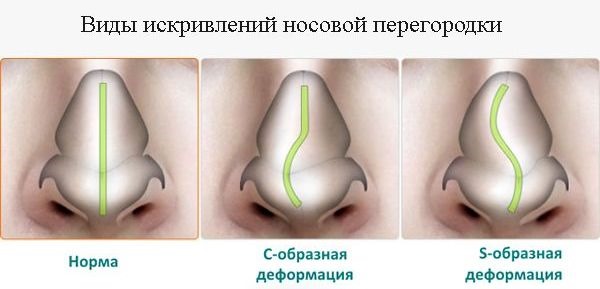
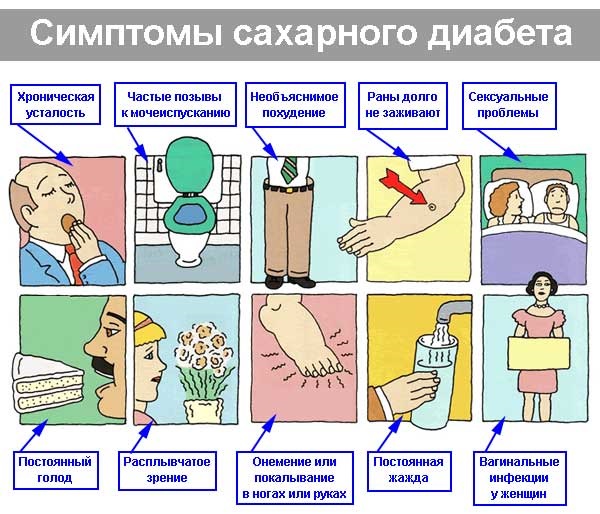
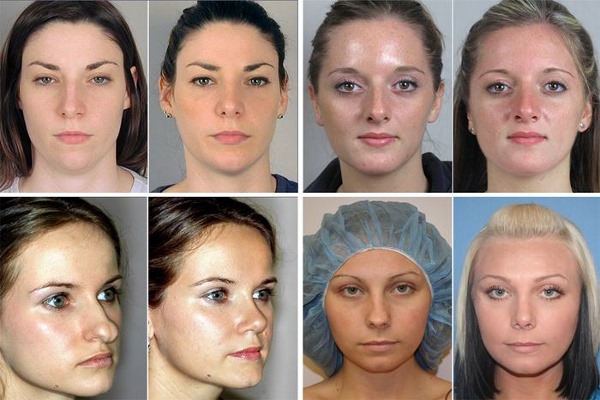


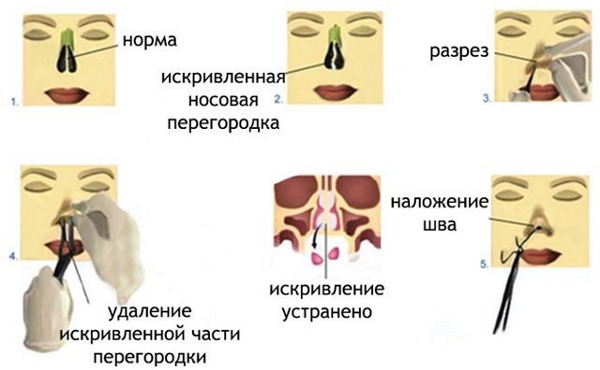
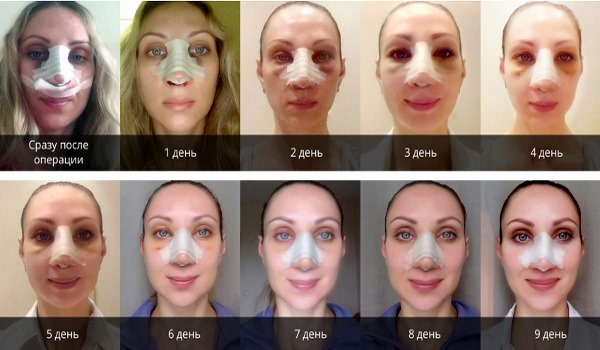
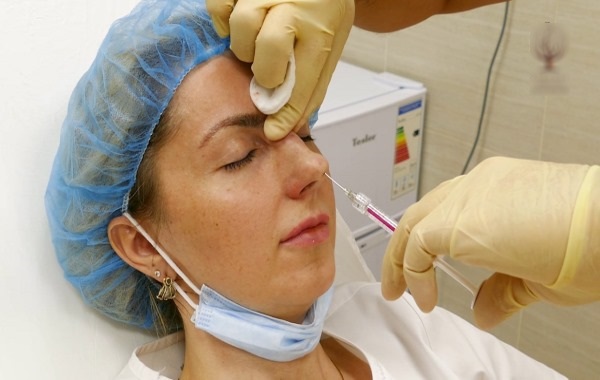
I am afraid of such operations, but probably in some cases one cannot do without them.